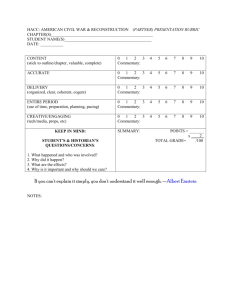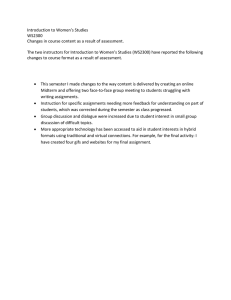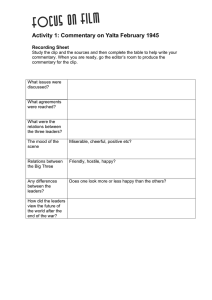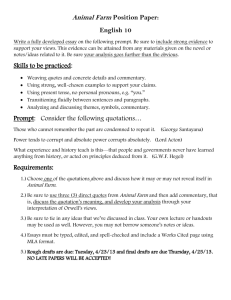Grading Student Writing - University of South Florida
advertisement
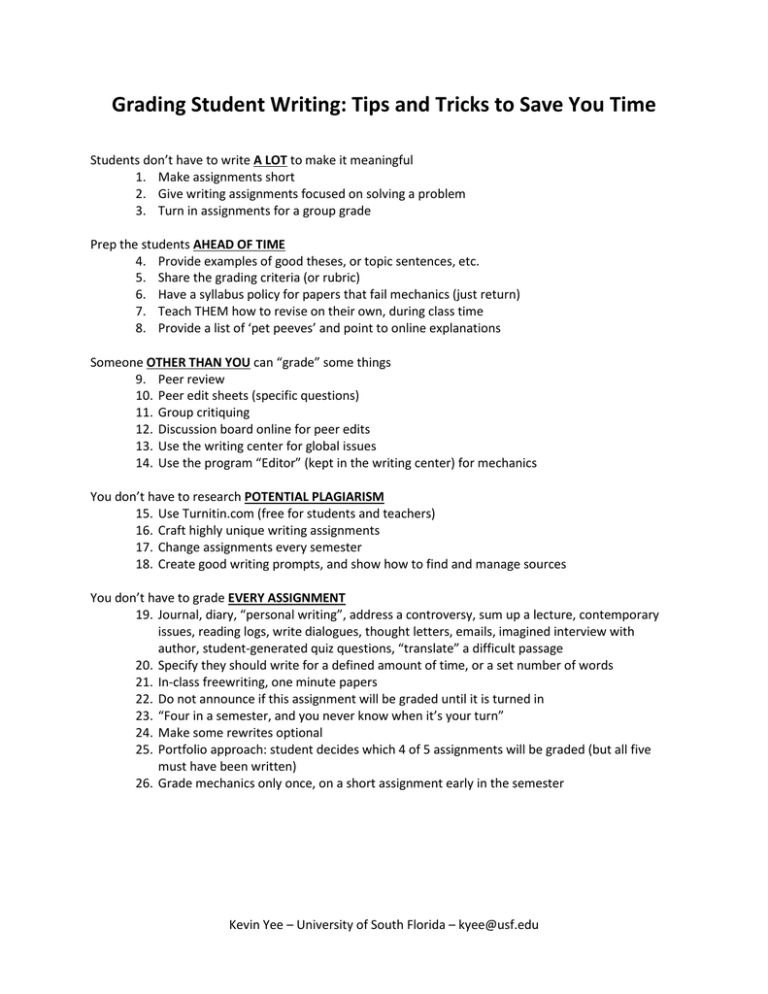
Grading Student Writing: Tips and Tricks to Save You Time Students don’t have to write A LOT to make it meaningful 1. Make assignments short 2. Give writing assignments focused on solving a problem 3. Turn in assignments for a group grade Prep the students AHEAD OF TIME 4. Provide examples of good theses, or topic sentences, etc. 5. Share the grading criteria (or rubric) 6. Have a syllabus policy for papers that fail mechanics (just return) 7. Teach THEM how to revise on their own, during class time 8. Provide a list of ‘pet peeves’ and point to online explanations Someone OTHER THAN YOU can “grade” some things 9. Peer review 10. Peer edit sheets (specific questions) 11. Group critiquing 12. Discussion board online for peer edits 13. Use the writing center for global issues 14. Use the program “Editor” (kept in the writing center) for mechanics You don’t have to research POTENTIAL PLAGIARISM 15. Use Turnitin.com (free for students and teachers) 16. Craft highly unique writing assignments 17. Change assignments every semester 18. Create good writing prompts, and show how to find and manage sources You don’t have to grade EVERY ASSIGNMENT 19. Journal, diary, “personal writing”, address a controversy, sum up a lecture, contemporary issues, reading logs, write dialogues, thought letters, emails, imagined interview with author, student-generated quiz questions, “translate” a difficult passage 20. Specify they should write for a defined amount of time, or a set number of words 21. In-class freewriting, one minute papers 22. Do not announce if this assignment will be graded until it is turned in 23. “Four in a semester, and you never know when it’s your turn” 24. Make some rewrites optional 25. Portfolio approach: student decides which 4 of 5 assignments will be graded (but all five must have been written) 26. Grade mechanics only once, on a short assignment early in the semester Kevin Yee – University of South Florida – kyee@usf.edu You don’t have to grade EVERY PART OF THE ESSAY 27. Sometimes, only grade for ‘effort’ (or that it’s done at all) 28. When turning in a draft, students specify which ONE element (organization, thesis, etc) they want you to evaluate, and you base the whole grade on this 29. Grade everything for content, but only grade one paragraph (or maybe one page) for writing skills and mechanics, to isolate the patterns 30. Revise early drafts, edit late drafts, grade final copies 31. Students resubmit first drafts (the portfolio model) and teachers only grade the changes 32. Students write a statement of what they changed (metacognition) Grade QUICKLY 33. Refuse to grade essays with too many errors or not meeting length requirements 34. Scan the paper instead of reading intently. Require subheadings? 35. Scan several essays quickly without grading, before picking up a pen 36. Grade everyone quickly without commentary, sort into piles, then adjust as needed and add (minimal) commentary 37. Divide the work over time: read only 5 or 10 essays per day 38. Find a distraction-free area to work in 39. Grade blindly (with a cover page you flip over) 40. Use the minus/check/plus system (add them up for the semester for a grade) 41. For short-answer essay tests, grade all responses to question #1 for the whole class at one time, rather than finishing one student’s test, and then move on to question #2 42. Don’t proofread; grade for content rather than to fix surface errors DON’T WRITE a lot of commentary 43. Over-commentary is confusing, discouraging, not helpful. Keep comments short. 44. Comment on drafts, but not final copies 45. Use rubrics: photocopy rubric, then underline & circle 46. Rubric shorthand (simply write the ‘cell’ number) or a “common mistakes” handout 47. Offer mp3 feedback rather than written 48. Type commentary rather than handwrite (or use Word’s “track changes” feature) 49. Start (and end?) with positive commentary 50. Provide only revision-oriented comments, not editing-oriented 51. Colored highlighters: one color for strengths, one for weaknesses (or use colors for the rubric elements) 52. Hold a face-to-face writing conference rather than write a lot of comments 53. Hold an in-class norming session before the due date, so they know what to expect 54. Make students initial a checklist as they hand in essay: “I started work on this paper three days ago,” “I spent at least five hours on this paper”, etc. 55. Use a “key” for the shorthand you write instead of commentary 56. Don’t explain grammar. Make students buy a style guide / writing guide 57. Provide plenary commentary. As you read/grade, take notes for plenary, not for individual feedback 58. Do not fix punctuation / grammar (but do mark it, and remove points). Just underline it. 59. Pick your battles: do not comment critically on more than one thing at a time 60. Assign points to value certain parts (organization = 30%, content = 30%, etc) Kevin Yee – University of South Florida – kyee@usf.edu


